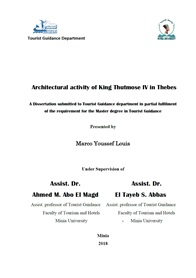
Thutmose IV is one of the little known kings of the 18th Dynasty not because he was a weak or unimportant ruler but simply because he did not rule a long time.
The length of his reign is not as clear as one would wish. He is usually given about nine or ten years of reign. Manetho credits him a reign of 9 years and 8 months.
Manetho’s other figures for the 18th Dynasty are frequently assigned to the wrong kings or simply incorrect, so monumental evidence is also used to determine hisreign length. Of all of Thutmose IV’s dated monuments, three date to his first regnal year, one to his fourth, possibly one to his fifth, one to his sixth, two to his seventh, and one to his eighth.
Thutmosis IV comes to the throne after his father Amenhotep II had reigned for 26 years. There are some indications that Thutmosis’s brother Amenhotep was crown prince, and that some power struggle ensued. The final result was that Prince Amenhotep disappears, the dowager Queen Merytre-Hatshepsut may have suffered disgrace. Her tomb in the King’s Valley is never used, and her monuments are usurped by Thutmosis’s mother Tiaa.
The known women of Thutmose IV were his mother Tiaa (ceremonially acted as his wife), Nefertiry, Iaret, Mutemwia, and a Mitanni princess. The first three were acknowledged Great Royal Wives during the king’s lifetime, although Iaret probably not until around his seventh year of rule. She took over some of the functions of the office perhaps at Tiaa’s death or at puberty. It is unknown whether Nefertiry continued to act as wife to Thutmose after Iaret became Great Royal Wife. Mutemwia was a minor queen who became the mother of Thutmose’s first surviving son.
In the royal ideology of the period, the king was divinely borne of the god Amun through his earthly mother. Through this union the king’s share of divinity was assured, and his mother was sanctified. Her role as King’s Mother was thus of enormous significance, both in Thebes as Mut and elsewhere as Isis, Hathor, Nekhbet or another goddess.
Thutmose IV did not have the great number of consorts attributed to him. Nefertiry was clearly his chosen wife, and Iaret, due to her family rank, replaced Tiaa. They, together with Tiaa, are the only Great royal wives known during Thutmose’s reign. Tiaa (as King’s Mother) and Nefertiry were simultaneously officiating with Thutmose IV, while Iaret appeared briefly towards the end of the king’s life.
The evidence for Asian relations with Egypt during Thutmose IV’s reign is often lacking in substance. In the southern regions of Palestine, Thutmose apparently effected a punitive action against Gezer.
The early years appear peaceful, and there is evidence of building projects at Karnak and other sites. There is some evidence of Asiatic wars in the beginning of his reign. There is reference to tribute from Naharin and Retenu.
Actual warfare cannot be proven, but he transported some people therefrom to Thebes. Some military activity against Mitanni vassals, probably in or before the king’s sixth year of rule can be supported. There is nothing to indicate Thutmose IV lost any of those cities in the area in fighting with Mitanni, but rather it appears that he claimed some type of victory over Nahrin vassals. It is presently impossible to prove that the Asian holdings of Egypt at the end of Thutmose’s reign were not similar to those of Amenhotep II.
Trends already visible in some sectors of society-such as increased interest in solar religion, a more elegant art style, and a growing desire for peace in Asia—were more pronounced in all aspects of the culture than before, but were in no way newly created. Neither were they fully evolved in Thutmose IV’s reign.

